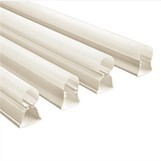As a seasoned supplier of Modified PC ABS, I've witnessed firsthand the widespread use and growing demand for this remarkable material. In the world of plastics, Modified PC ABS and polycarbonate are two popular choices, each with its own unique set of properties and applications. Understanding the differences between them is crucial for making informed decisions in various industries. In this blog post, I'll delve into the key disparities between Modified PC ABS and polycarbonate, shedding light on their characteristics, advantages, and limitations.
Composition and Structure
Let's start with the basics: composition and structure. Polycarbonate (PC) is a thermoplastic polymer known for its high impact resistance, transparency, and heat resistance. It is a linear, amorphous polymer made up of carbonate groups linked by aromatic rings. The chemical structure of polycarbonate gives it excellent mechanical properties, making it suitable for applications where strength and clarity are essential, such as optical lenses, automotive headlamps, and electronic device housings.
On the other hand, Modified PC ABS is an alloy of polycarbonate (PC) and acrylonitrile-butadiene-styrene (ABS). ABS is a terpolymer composed of acrylonitrile, butadiene, and styrene monomers. The combination of PC and ABS results in a material that combines the best properties of both polymers. Modified PC ABS offers improved impact resistance, processability, and chemical resistance compared to pure ABS, while also retaining some of the desirable characteristics of polycarbonate, such as heat resistance and dimensional stability.
Mechanical Properties
One of the most significant differences between Modified PC ABS and polycarbonate lies in their mechanical properties. Polycarbonate is renowned for its exceptional impact resistance, even at low temperatures. It can withstand high levels of stress without cracking or breaking, making it ideal for applications where safety and durability are paramount. For example, polycarbonate is commonly used in bulletproof glass, safety helmets, and protective shields.
Modified PC ABS also exhibits good impact resistance, but it may not be as high as that of pure polycarbonate. However, Modified PC ABS offers better processability and flow characteristics, which makes it easier to mold into complex shapes. This makes it a popular choice for injection molding applications, such as automotive interior parts, consumer electronics, and household appliances.


In terms of tensile strength and stiffness, polycarbonate generally has higher values compared to Modified PC ABS. Polycarbonate can withstand higher loads and has better dimensional stability under stress. However, Modified PC ABS can be formulated to have specific mechanical properties tailored to the requirements of different applications. For example, by adjusting the ratio of PC to ABS and adding appropriate additives, Modified PC ABS can be made to have higher stiffness or improved impact resistance.
Heat Resistance
Heat resistance is another important factor to consider when comparing Modified PC ABS and polycarbonate. Polycarbonate has excellent heat resistance, with a high glass transition temperature (Tg) of around 145°C to 150°C. This means that polycarbonate can maintain its mechanical properties and dimensional stability at elevated temperatures. It is commonly used in applications where exposure to high temperatures is expected, such as automotive engine components, electrical connectors, and industrial machinery parts.
Modified PC ABS also has good heat resistance, but it may not be as high as that of pure polycarbonate. The heat resistance of Modified PC ABS depends on the ratio of PC to ABS and the presence of any heat stabilizers or additives. Generally, Modified PC ABS can withstand temperatures up to around 100°C to 120°C, which is sufficient for many applications. For applications that require higher heat resistance, you can check out our Heat Resistance PCABS Alloy, which is specially formulated to provide enhanced thermal stability.
Chemical Resistance
Chemical resistance is an important consideration for materials used in applications where they may come into contact with various chemicals. Polycarbonate has good resistance to many chemicals, including acids, bases, and solvents. However, it can be susceptible to stress cracking when exposed to certain organic solvents, such as acetone and methyl ethyl ketone (MEK).
Modified PC ABS generally has better chemical resistance compared to pure ABS, but it may not be as resistant as polycarbonate. The chemical resistance of Modified PC ABS depends on the composition of the alloy and the type of additives used. In general, Modified PC ABS is more resistant to chemicals than pure ABS, but it may still be affected by some solvents and chemicals. It is important to consider the specific chemical environment when selecting a material for a particular application.
Cost
Cost is often a significant factor in material selection. Polycarbonate is generally more expensive than Modified PC ABS. The higher cost of polycarbonate is due to its superior mechanical properties, heat resistance, and transparency. However, the cost of Modified PC ABS can be adjusted by varying the ratio of PC to ABS and using different additives. This makes Modified PC ABS a more cost-effective option for many applications where the high performance of polycarbonate is not required.
Applications
The differences in properties between Modified PC ABS and polycarbonate make them suitable for different applications. Polycarbonate is commonly used in applications where high impact resistance, transparency, and heat resistance are required, such as optical lenses, automotive headlamps, safety shields, and electronic device housings.
Modified PC ABS, on the other hand, is widely used in injection molding applications, such as automotive interior parts, consumer electronics, household appliances, and office equipment. Its good impact resistance, processability, and cost-effectiveness make it a popular choice for these applications. For general-purpose applications, our General Purpose PCABS Alloy offers a balanced combination of properties at a competitive price. And for applications where flame retardancy is required, our Flame Retardant Grade PCABS Alloy provides enhanced fire safety.
Conclusion
In conclusion, Modified PC ABS and polycarbonate are two distinct materials with their own unique properties and applications. Polycarbonate offers superior impact resistance, transparency, and heat resistance, but it is more expensive. Modified PC ABS, on the other hand, combines the advantages of PC and ABS, offering good impact resistance, processability, and cost-effectiveness. When choosing between Modified PC ABS and polycarbonate, it is important to consider the specific requirements of your application, such as mechanical properties, heat resistance, chemical resistance, and cost.
As a supplier of Modified PC ABS, I am committed to providing high-quality materials that meet the diverse needs of our customers. If you have any questions or need further information about our products, please feel free to contact us. We look forward to discussing your requirements and exploring how our Modified PC ABS solutions can benefit your business.
References
- "Engineering Plastics: Properties and Applications" by Donald V. Rosato, Dominick V. Rosato, and Joseph P. Boniface
- "Plastics Materials" by John A. Brydson
- "Handbook of Thermoplastics" edited by O. Olabisi




